|
Basic
Finger Articulation
Playing music involves more than just playing the right note at the right
time. The way the notes are
played, the articulation, is of equal importance as
pitch and duration. Music articulation is in many
ways comparable to
articulation in poetry or acting. The way words are pronounced, sentences formed
etc. are of the utmost importance. Without articulation a poem or text would
sound very monotonous
and boring. The same goes for music. When a player limits himself to just pushing keys, his
music
will sound just as monotonous.
In music we distinguish three basic forms of articulation;
On instruments with bellows, like the concertina, these articulation forms
can be performed in 3
different ways:
- finger articulation:
- bellows articulation
- finger/bellows articulation
In this section we will discuss the first method, finger articulation.
Legato
Legato is indicated by either a slur over or under two or more notes of
different names, or the
word legato printed in the score. Legato means: connected, in an even, smooth and gliding manner.
To play legato, play the note until the next note starts, without creating a gap
between notes.
When playing finger legato, the movement of the two fingers, one
lifting up and one pushing
down, has to be executed exactly at the same time. It
is not possible to play finger legato using
the same finger, because the time
needed to lift up the finger and push it down again always
creates a noticeable
gap between the notes.
Always keep your fingers close to the keys. The finger 'speed' of both
movements, lifting up and
pushing down, should be the same, especially when
alternating left and right hand. Make sure the
pressure points are even (see holding the instrument). If you use
your playing fingers also to hold
the instrument, you might find it hard to lift
up your finger on time. This will cause the notes to
overlap.
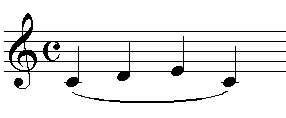
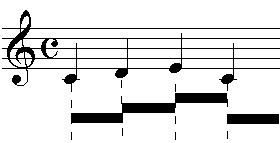
Legato slur
The bar indicates the sound of the note.
Portato
Portato is indicated by a short line over or under a note, or the
combination of a slur and staccato
dot. It can also be indicated by the word
portato printed in the score. Portato means: lengthened,
sustained.
To play portato, sound the note about 50-75% of the length of the notated
value. The notes
should always be separated by a rest. Finger-portato is
probably the easiest articulation form to
perform. Because of the time between
two notes, it does not require any special technique.
Pay attention to the lifting up of your finger, which determines the length of
the tone you are
playing. If you play several portato notes in succession, make
sure they are the same length.
Again, make sure your pressure points are even (see holding the instrument).
If you use your
playing fingers also to hold the instrument, you might find it
hard to lift up your finger on time,
which results in an uneven portato.
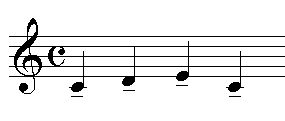

Portato notation The
bar indicates the length (50%) of the tone
Staccato
Staccato is indicated by a dot over or under a note. It can also be indicated by
the word staccato
printed in the score. Staccato means: detached, separated.
Just as with portato, the actual sound of a staccato note is shorter than
the notated value. The
actual length of the tone should be about 10-20% of the
notated value.
Finger-staccato is the hardest finger articulation form to perform, because of
the speed of the
finger movement required, and the unevenness of the fingers,
especially the weaker fingers 3 and 4
(ring and little finger).
When you try to play staccato by 'tapping' your fingers on the keys, you'll
notice that it is impossible to obtain evenness between the fingers. Your index
and middle finger
will perform a 'crispier' staccato than the ring and little
finger.
The best way to guarantee uniform staccato with all fingers, is to reverse the
movement. When you
pull away your fingers, instead of tapping, you will use
your hand muscles. Since these muscles are
used for all fingers, this will automatically guarantee the required degree of evenness. The actual
movement can
best be compared to the movement you'll make when you touch something very hot.
When you pull away your hand in this manner, the finger touching a key at that
moment will first
go down before lifting up. It makes a jumping movement. The
finger itself does not do anything,
it passively follows the hand.
In order to allow your hand the degree of flexibility required to perform
this movement, make
sure your pressure points are even (see holding the
instrument). Again, if you use your playing
fingers also to hold the instrument, it will be impossible to perform this hand movement.
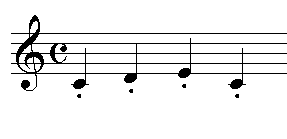
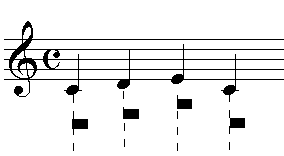
Staccato notation The
bar indicates the length (10-20%) of the tone.
The following example shows a variety of articulation forms used in a simple
phrase. Note that
the last (second) note under the slur, 'a' and 'f ', are
automatically played shorter than the first note.
This way the phrasing of two
notes becomes audible. Also, note that the legato 8th note has the
same length
as the portato quarter note.
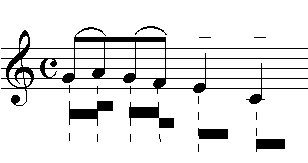
|






